What happens when you get a Chiropody Treatment?
Maybe this is your first visit to a chiropodist and are you wondering what will happen to you or what you should or should not do before you visit me.
Therefore, a brief overview of the different parts of the different treatments and the Do’s and Don’ts.
Do
• Make a list of your complaints and any questions you may have for me
• Make a list of the medicines you use and the operations you have undergone
• Take your (old) walking and/or running shoes with you
• Remove your nail polish
And of course you have properly washed and dried your feet
Don’t
• Shave your legs because that makes your legs and feet vulnerable to fungal and bacterial infections.
• Cut your nails yourself because I cannot cut something into shape if it is no longer there.
Chiropody Treatments
Intake
 At your first time visit, I will examine your feet and ask you some personal questions such as what complaints you have, what you use your feet for (do you stand a lot, walk often, do you regularly play sports), or are you perhaps a diabetic or have rheumatism. If necessary, I also make blueprints of your feet so that I can more efficiently map out possible problems.
At your first time visit, I will examine your feet and ask you some personal questions such as what complaints you have, what you use your feet for (do you stand a lot, walk often, do you regularly play sports), or are you perhaps a diabetic or have rheumatism. If necessary, I also make blueprints of your feet so that I can more efficiently map out possible problems.
If it turns out that you suffer from certain things that cannot be treated by me, I will of course tell you immediately and refer you to your doctor. But in most cases this won’t be necessary and I can start treatment immediately.
I will store your data in my customer database. Of course your data will be treated confidentially and will not be sold to anyone. For further information please read the privacy statement.I am keeping your data because I am thus able to start your treatment straight away the following time you visit me. It will also be a reference point for checking and further treating points and/or complaints which we discussed in our first visit.
Desinfecting feet
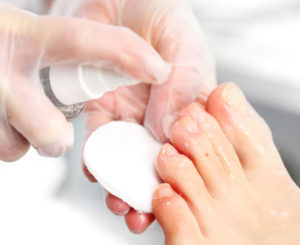 Of course you just washed your feet when you arrive. And yet, before I do anything else, I will first disinfect your feet. Because unfortunately, fungi and bacteria are not visible. And to prevent possible contamination from one foot to the other, I find that I would rather disinfect one time too often than too little.
Of course you just washed your feet when you arrive. And yet, before I do anything else, I will first disinfect your feet. Because unfortunately, fungi and bacteria are not visible. And to prevent possible contamination from one foot to the other, I find that I would rather disinfect one time too often than too little.
Treating fungal nails
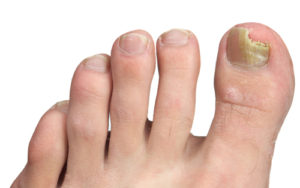 If you have one or more fungal nails, it is advisable to do something about it sooner rather than later.
If you have one or more fungal nails, it is advisable to do something about it sooner rather than later.
The tricky thing is that the resources available for topical (external) treatments are not effective for everyone. Very often it’s a matter of trial and error and hope for positive results.
In addition, you are expected to seriously work on getting your fungus nails under control by following the advice that I will give you.
The treatment itself contains of flattening your nail and remove as much of the nail and the bacteria underneath is as possible. The thinner the nail the bigger the chance the product will be able to get to the fungus. Generally you’ll have to come back once a month, as long as the fungal nail remains thick.
Cutting nails
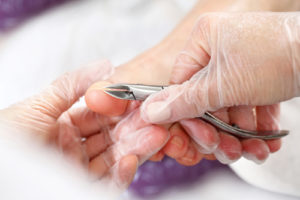 I cut the nails short with special nail pliers. Of course I will leave the nail as straight as possible because cutting the corners round increases the chance of an ingrown nail. Furthermore, I do not cut them too short and, if possible, I leave a few millimeters of white visible. Nails provide protection against external influences such as fungi.
I cut the nails short with special nail pliers. Of course I will leave the nail as straight as possible because cutting the corners round increases the chance of an ingrown nail. Furthermore, I do not cut them too short and, if possible, I leave a few millimeters of white visible. Nails provide protection against external influences such as fungi.
Cleaning the nail area
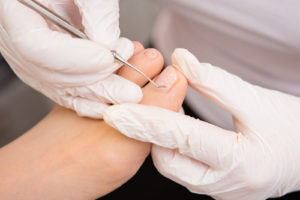 Meanwhile, I sprayed a substance on your cuticles and nail rims in order to soften them. I then will clean your nails using different tools such as, for example, an excavator. This instrument in particular looks like a device also used by dentists. With this I remove callus, dead cell tissue and other substances in the nail walls and under the nail.
Meanwhile, I sprayed a substance on your cuticles and nail rims in order to soften them. I then will clean your nails using different tools such as, for example, an excavator. This instrument in particular looks like a device also used by dentists. With this I remove callus, dead cell tissue and other substances in the nail walls and under the nail.
Buffing your nails
 I will then use my special motor to neatly mill your nails into shape and thus make sure that there are no sharp edges left which may ruin your socks or stockings. I will finish the nails off by buffing them and make them extra soft and shiny so that, for the ladies, nail polish will be completely unnecessary.
I will then use my special motor to neatly mill your nails into shape and thus make sure that there are no sharp edges left which may ruin your socks or stockings. I will finish the nails off by buffing them and make them extra soft and shiny so that, for the ladies, nail polish will be completely unnecessary.
Manually removing a normal amount of callus
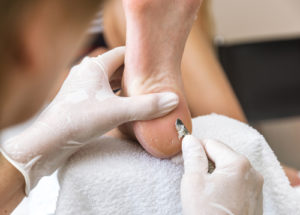 I realize that a ‘normal amount’ is an arbitrary concept so if you have any doubts about whether the amount of callus you have is normal send me a whatsapp with a photo.
I realize that a ‘normal amount’ is an arbitrary concept so if you have any doubts about whether the amount of callus you have is normal send me a whatsapp with a photo.
I will remove most of the callus with a scalpel (a surgical knife). That may look a little scary but believe me: I know what I am doing and this treatment is completely painless because I only remove dead skin cells (callus).
The advantage of callus cutting instead of milling is that it is faster and callus will return less quickly. The vibrations of the cutter causes friction and the friction was precisely the reason why you got so much callus in the first place.
Removing a corn
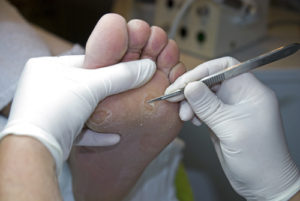 To remove a corn, I use a scalpel, a small surgical knife. Just as with the removal of callus, you may think that the use of such a knife will be painful, but you won’t feel much at all. Usually the corn itself hurts more than removing it. I often hear: “The pain is finally gone”.
To remove a corn, I use a scalpel, a small surgical knife. Just as with the removal of callus, you may think that the use of such a knife will be painful, but you won’t feel much at all. Usually the corn itself hurts more than removing it. I often hear: “The pain is finally gone”.
If the corn is very deep, I may not be able to avoid giving you a small cut, but with some disinfectants and a plaster this will be completely healed in a couple of days.
Removing verrucas
 It usually takes a good few months to remove verrucas (foot warts). When I start with the treatment I will begin with cutting away the excess callus on top of and around the verrucas. I do this to make sure the packing with salicylic acid ointment, which I will put on it afterwards, is able to reach the inside of the verrucas and be thus more effective.
It usually takes a good few months to remove verrucas (foot warts). When I start with the treatment I will begin with cutting away the excess callus on top of and around the verrucas. I do this to make sure the packing with salicylic acid ointment, which I will put on it afterwards, is able to reach the inside of the verrucas and be thus more effective.
At home you will have to continue the treatment and apply the ointment yourself, preferably in the evening just before you go to bed so it works all through the night as well.
After a couple of weeks I will repeat the callus removal treatment again and we then continue with the ointment
We will keep on going doing the same thing until the verrucas are gone and your skin is completely smooth and soft again. This could take as much as three months, but the treatment is painless and is ultimately more effective than other methods.
Smoothing your feet mechanically
 After cutting I use, briefly, the cutter to make your feet feel smooth and even. This may be a little tickling initially but in this feeling generally subsides after half a minute.
After cutting I use, briefly, the cutter to make your feet feel smooth and even. This may be a little tickling initially but in this feeling generally subsides after half a minute.
Scrubbing feet
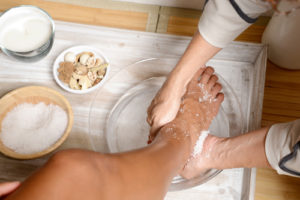 If you opt for a luxurious treatment I will, of course, also remove dead skin cells from your feet. With ProNails special foot scrub I will make rubbing movements over the skin of both feet, both on top as well as on the bottom of your feet. It will feel a bit like a rough massage
If you opt for a luxurious treatment I will, of course, also remove dead skin cells from your feet. With ProNails special foot scrub I will make rubbing movements over the skin of both feet, both on top as well as on the bottom of your feet. It will feel a bit like a rough massage
Scrubbing removes any rough and hard spots and because the dead skin cells are removed, the growth of the healthy skin underneath is promoted. Your feet feel wonderfully soft and smooth after this treatment.
Door het scrubben verdwijnen eventuele ruwe en harde plekjes en doordat de dode huidcellen zijn verwijderd wordt de groei van de gezonde huid daaronder bevorderd. Je voeten voelen na deze behandeling weer heerlijk zacht en glad.
Relaxing feet massage with nourishing cream
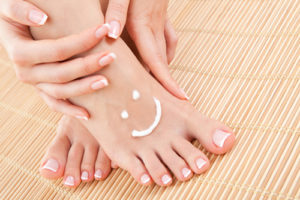 After the treatments, your feet need a nourishing and moisturizing cream so that the treatment I’ve just given them will last for as long as possible. I use a specialized foot foam from ProNails which you, if you so prefer, can buy from me afterwards.
After the treatments, your feet need a nourishing and moisturizing cream so that the treatment I’ve just given them will last for as long as possible. I use a specialized foot foam from ProNails which you, if you so prefer, can buy from me afterwards.
Wrap with a ProNails Vitamin Mask
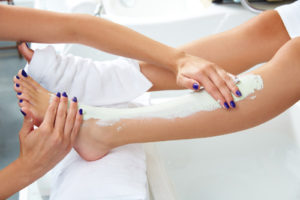 I will apply a cream mask to your feet and legs and wrap this up with wrapping foil. You’ll get to relax with a cup of coffee or tea and a treat so the mask can do its work for 5 to 10 minutes, depending on which mask you choose. After I remove the foil I will massage leftover cream into your skin by hand.
I will apply a cream mask to your feet and legs and wrap this up with wrapping foil. You’ll get to relax with a cup of coffee or tea and a treat so the mask can do its work for 5 to 10 minutes, depending on which mask you choose. After I remove the foil I will massage leftover cream into your skin by hand.
Polishing your nails
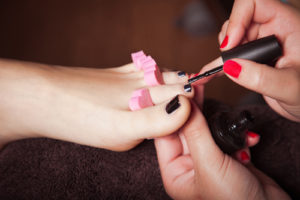 For finishing the nails I work with the NCM (Nail Care Manon) gel polish.
For finishing the nails I work with the NCM (Nail Care Manon) gel polish.
This varnish can be applied over the natural toenails, but also over a nail that has been built up and/or repaired with NCM sculpture gel.
The beautiful, firming colour layer is applied on a slightly roughened nail and cured with an LED lamp. The lacquer is a so-called Soak Off lacquer which means that the nails are not damaged by filing off the old layer of gel.
The gel lacquer can, under normal use, sit on the nails of the feet for up to 6 weeks without any loosening or damage. On the nails of the hands, it will be slightly shorter.
NCM gel polish is oxygen permeable and can also be used on mycosis nails (fungal nails) or lime nails. On mycosis nails only in combination with an anti-mycosis nail tincture.
Specialist Techniques
Corrective nail braces
 Growing or ingrowing nails can start to hurt if the nail presses deep into the nail bed and causes inflammation. This could lead to serious complications when people have rheumatism or diabetes. Nail braces are regulating the (in)growing nail and guides the nail away from the nail bed.
Growing or ingrowing nails can start to hurt if the nail presses deep into the nail bed and causes inflammation. This could lead to serious complications when people have rheumatism or diabetes. Nail braces are regulating the (in)growing nail and guides the nail away from the nail bed.
There are different types of braces and, for each client, I will find the most suitable brace. The advantage of a nail brace is that the client is pain-free almost immediately after application. Due to the tensile strength of the brace, the nail is pulled up and out of the nail wall. The brace will grow out with the nail. Normally the nail will grow properly after an intervention with nail braces, but in some cases, this treatment needs to be done repeatedly.
After the treatment, you will receive a leaflet explaining what you should and should not do with your nail brace.
Custom-made toe props
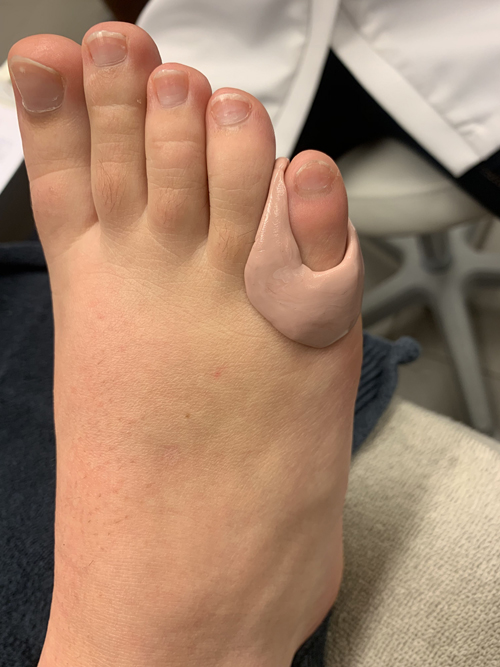
A silicone toe prop is a small aid meant to relieve pressure spots between or on your toes. For example, when you have a corn between your toes or a hammer toe that pushes against your shoe and is causing you pain. Toe props can also have a corrective effect, but corrective toe props are not made by a chiropodist. You can contact the podiatrist for this.
I will make you a pressure-distributing toe prop exactly the right size to ensure a perfect fit. You will probably have to wear this prop permanently unless there is a clear explanation for the pressure spot which can be remedied.
At the end of the treatment, you will receive a leaflet explaining what you should and should not do with your silicone toe prop.
Pressure relief with felt therapy
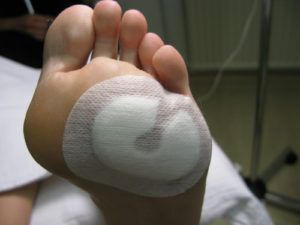 For temporary relief of pressure on and under the feet, I apply felt padding. Temporary pressure distribution may be necessary because the wound of corn or an ingrowing nail is still painful, but it may also be that temporary padding is applied in anticipation of a more permanent solution that is constructed by the podiatrist.
For temporary relief of pressure on and under the feet, I apply felt padding. Temporary pressure distribution may be necessary because the wound of corn or an ingrowing nail is still painful, but it may also be that temporary padding is applied in anticipation of a more permanent solution that is constructed by the podiatrist.
I use felt with a thickness of 3-10 mm, depending on the place on the foot or in the shoe. I cut the felt to size, stick it where it is needed and cover it with smooth patches. The padding can stay in place for 2 to 5 days.
After the treatment, you will receive a leaflet explaining what you should and should not do with your felt padding.
Toenail reconstruction
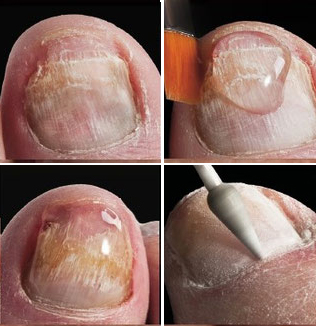 Sometimes you don’t have a complete toenail because of bumps or the deliberate removal of a fungal nail. Toenail reconstruction is mainly a cosmetic procedure. I work with acrylic or gel, depending on various factors such as how much of the real nail is left and the reason for the damage.
Sometimes you don’t have a complete toenail because of bumps or the deliberate removal of a fungal nail. Toenail reconstruction is mainly a cosmetic procedure. I work with acrylic or gel, depending on various factors such as how much of the real nail is left and the reason for the damage.
With acryl or gel, I make an artificial nail that is applied directly to the nail bed or on top of the ugly real nail and is cured with the help of UV-light to create a brand new nail.
The artificial nail is not a permanent solution. The nail grows along with your real nail. You need to come by every four to six weeks and will either apply a new artificial nail or fill the gap. We will repeat this procedure until your real nail is fully grown again.
After the treatment, you will receive a leaflet explaining what you should and should not do with your artificial nail.
Screening & examination
Annual screening/blueprints

A blueprint, an ink print of the feet, provides information on the movement of the foot while walking and on the pressure points in the foot while standing and walking. With this information, I can determine what type of foot you have and the position, the pressure points and the points of the unwinding of your feet. After that, I can often also explain why you have certain complaints such as, for example, too much callus.
Usually, I also look at other things using the blueprints such as the exact length, the width and the ball size of your foot. I will subsequently inspect your socks and shoes.
Based on all this information, I will give you free advice about possible treatment, referral to a specialist or which type of shoe is suitable for your foot and what size you need.
Screening rheumatism & diabetes feet
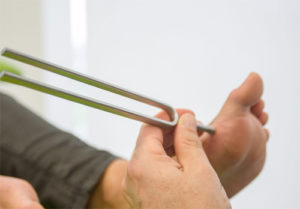 Full foot screening is especially important for people with diabetes or rheumatism. In these patients, wounds to the foot can occur more quickly, and healing is often more difficult and longer-lasting than in healthy people.
Full foot screening is especially important for people with diabetes or rheumatism. In these patients, wounds to the foot can occur more quickly, and healing is often more difficult and longer-lasting than in healthy people.
Screening means that I will carry out several tests with which I can recognize (possible) complications at an early stage that may be the result of diabetes mellitus or a rheumatic disorder.
We will then discuss the results of the screening together, and if I have discovered any risks, I will send you to the family doctor or podiatrist.
Fungal nail screening
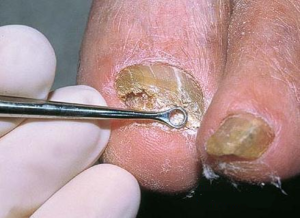 Fungal nails are a common problem whereby nails are often yellow/green/brown coloured and are thick and crumbly.
Fungal nails are a common problem whereby nails are often yellow/green/brown coloured and are thick and crumbly.
Usually, fungal nails are caused by a fungal infection and healing happens seldom naturally. Once infected, all nails need to be treated to prevent expansion. There are different treatments available but all of those are only successful if we cooperate.
However, not every discoloured nail is a fungal nail. And if your discoloured nail does not respond to different antifungal agents, and you feel you have already tried everything but nothing works, it can be useful to investigate if the discolouration in your nail really is a fungus.
I test the presence of fungi with a very small piece of your nail, which I send to the Scientific Laboratory for Fungus Diagnostics of the University Medical Centre of the University of Nijmegen (UMC St. Radboud) and, within 10 days, we will know for sure whether it is indeed a fungus nail.
If the test turns out to be positive, we can determine any subsequent steps, but if it is not a fungal nail, we can adjust the treatment accordingly.